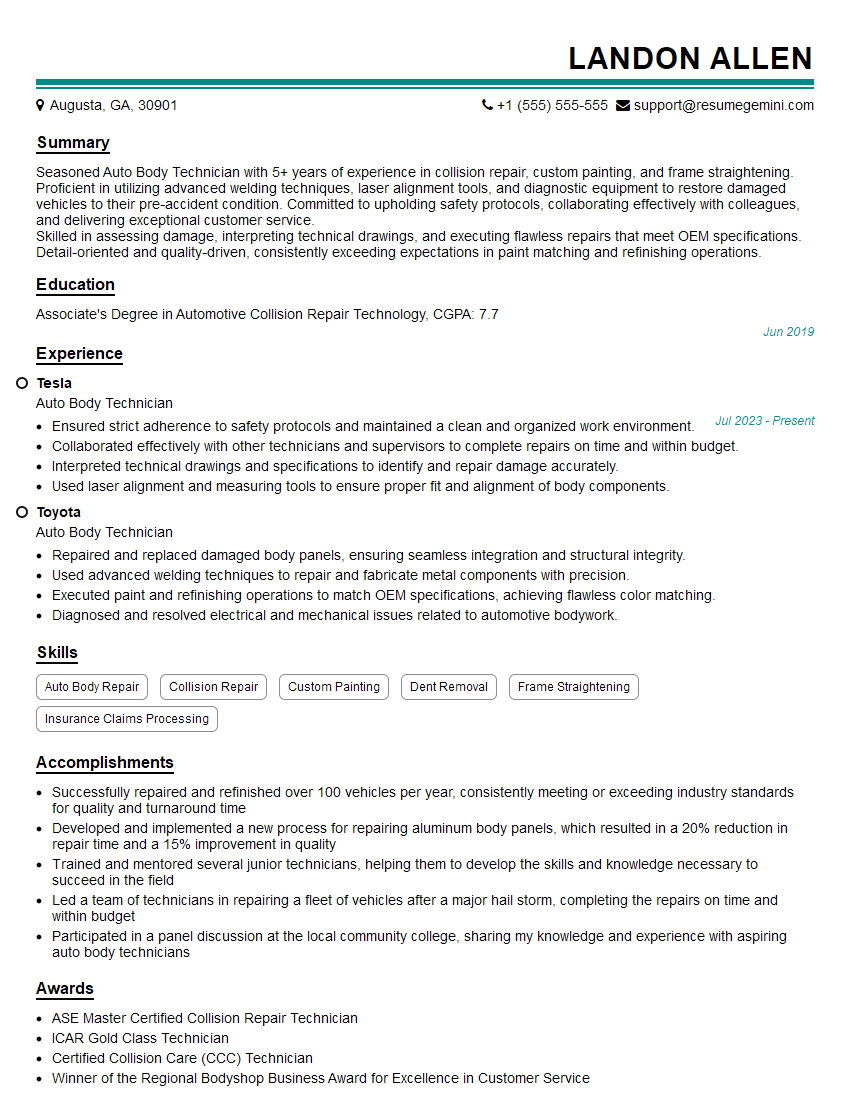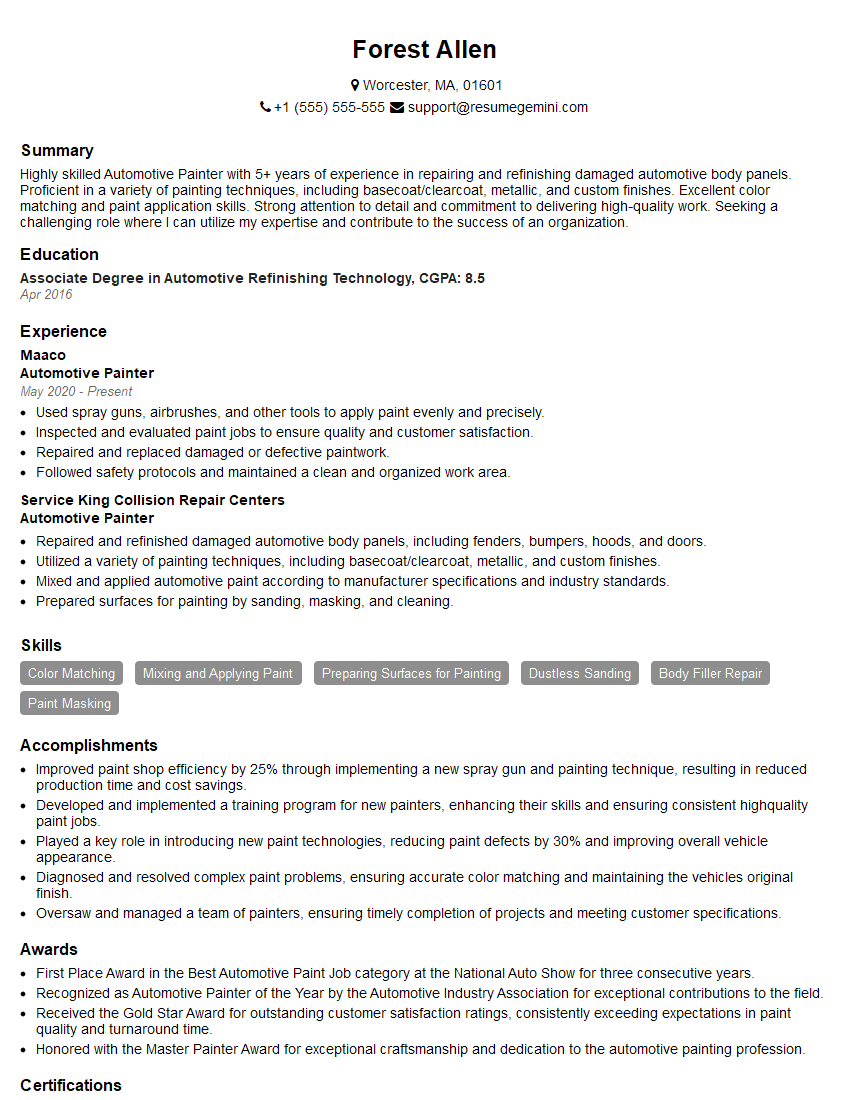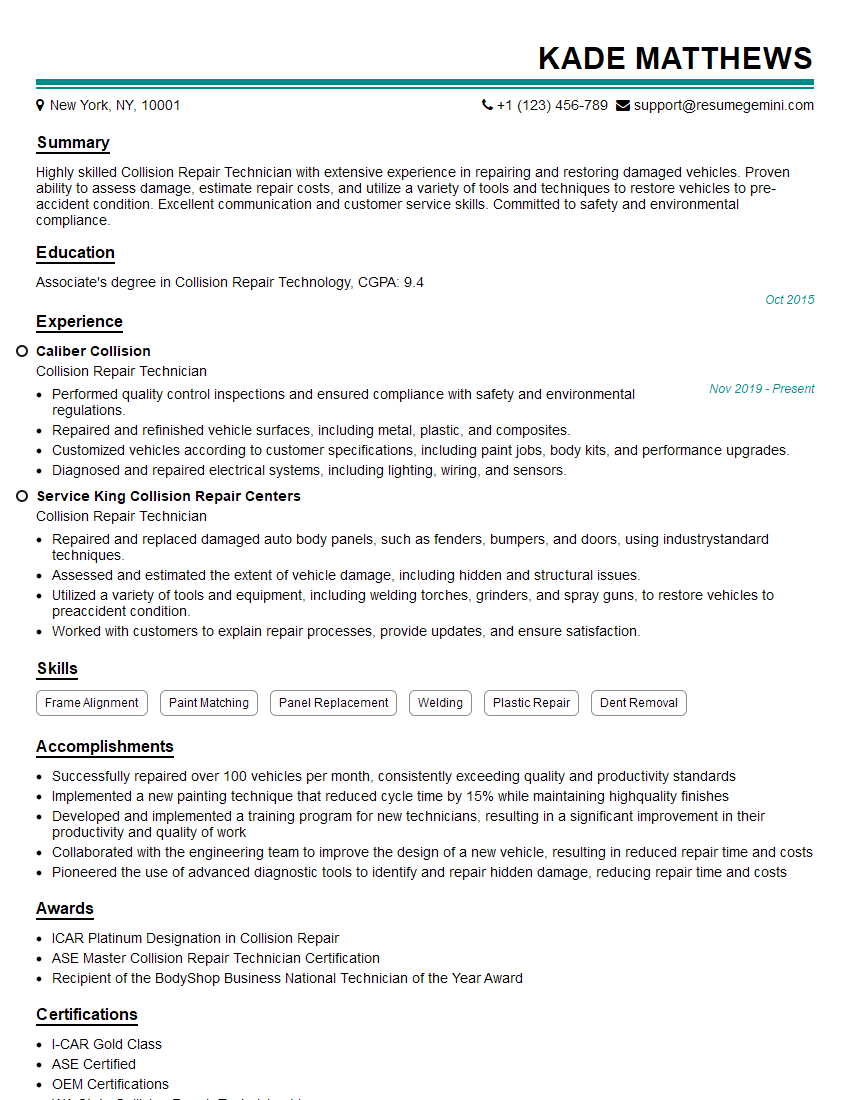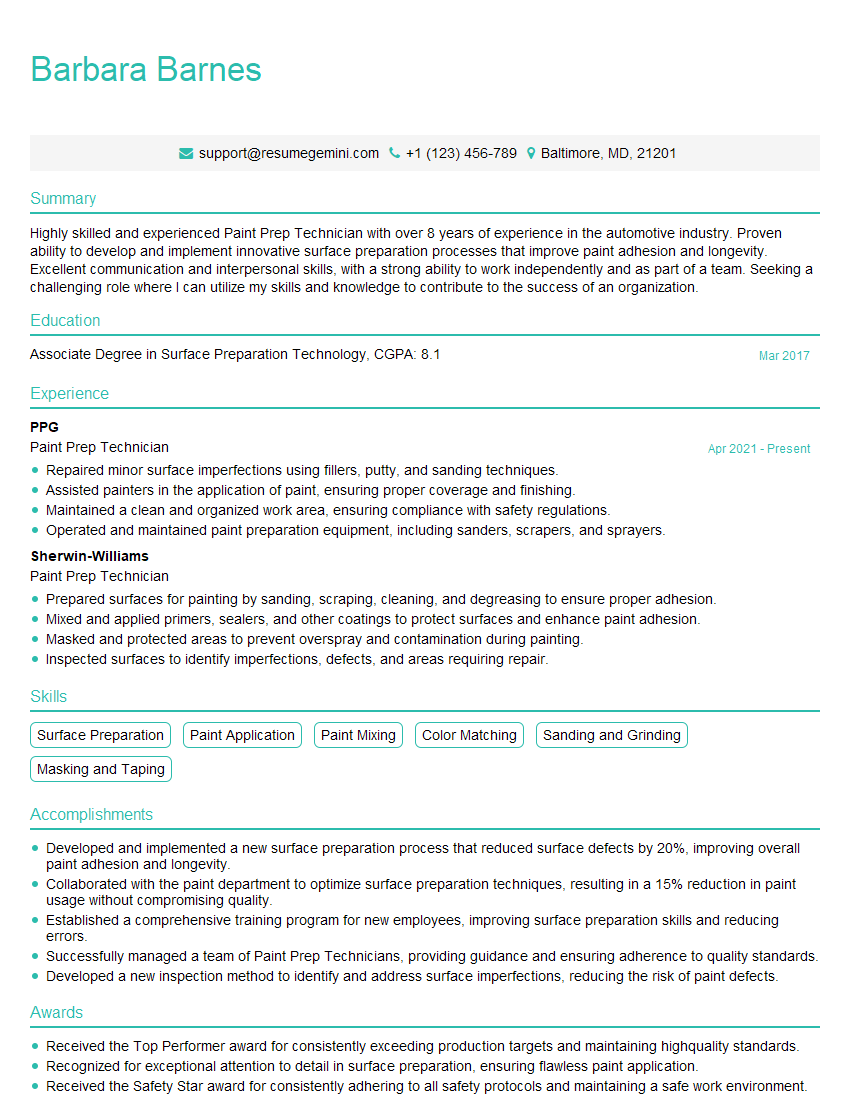Feeling uncertain about what to expect in your upcoming interview? We’ve got you covered! This blog highlights the most important Wet Sanding interview questions and provides actionable advice to help you stand out as the ideal candidate. Let’s pave the way for your success.
Questions Asked in Wet Sanding Interview
Q 1. What grit sizes of sandpaper do you typically use for wet sanding, and why?
Wet sanding uses a progression of grits, each removing progressively finer scratches. I typically start with a relatively coarse grit like 1500-grit to remove larger imperfections, then move to 2000-grit, and finally 3000-grit for an ultra-smooth finish before polishing. The choice depends on the severity of the damage; deeper scratches might require starting with even coarser grits (e.g., 1000-grit), while a perfectly clear coat might only need 2000-grit and higher.
- 1500-grit: Removes major imperfections, level sanding, aggressive
- 2000-grit: Refines the surface, removes 1500-grit scratches
- 3000-grit: Creates a very smooth surface, ready for polishing
Think of it like sanding wood – you wouldn’t start with the finest sandpaper! You need to gradually reduce the scratch size.
Q 2. Describe your process for wet sanding automotive clear coat.
Wet sanding automotive clear coat is a delicate process requiring patience and precision. My process involves:
- Preparation: Thoroughly clean the area to be sanded, removing any dirt, debris, or contaminants. Masking off surrounding areas is crucial to prevent accidental sanding.
- Initial Sanding (1500-grit): Using a sanding block and plenty of lubrication (I’ll detail my lubricant preference later), I start with 1500-grit sandpaper, working in overlapping strokes, keeping the sandpaper flat and even pressure. I frequently rinse the area and the sandpaper to clear away sanding slurry.
- Progressive Sanding: I then move to 2000-grit, followed by 3000-grit, repeating the process for each grit. Each grit step removes the scratches from the previous step.
- Inspection: After each grit, I thoroughly inspect the surface under various lighting conditions to check for remaining scratches. This is vital to avoid going too far.
- Final Rinse and Dry: Finally, I rinse the sanded area thoroughly with clean water and dry it completely before polishing.
Remember, consistency in pressure and movement is key to achieving a uniform finish. Over-sanding can lead to problems, so proceed carefully.
Q 3. How do you prevent swirl marks during wet sanding?
Swirl marks are a common problem in wet sanding, caused by inconsistent sanding technique or pressure. Preventing them requires a methodical approach:
- Proper Technique: Use a sanding block to maintain consistent pressure and a flat sanding surface. Use long, even, overlapping strokes in one direction, avoiding circular motions.
- Lubrication: Ample lubrication helps to prevent the sandpaper from grabbing and creating swirl marks. The lubricant acts as a cushion.
- Frequent Rinsing: Regularly rinse the surface and the sandpaper to remove accumulated sanding slurry. A build-up of this slurry can increase friction and cause swirl marks.
- Light Pressure: Avoid excessive pressure. Let the sandpaper do the work. Too much pressure can quickly cut through the clear coat.
- Sharp Sandpaper: Use fresh sandpaper whenever necessary. Dull sandpaper requires more pressure and is more likely to cause swirl marks.
Think of it like drawing: smooth, consistent strokes create a clean line, while erratic pressure leads to a wobbly one.
Q 4. Explain the importance of proper lubrication during wet sanding.
Proper lubrication is absolutely critical during wet sanding. It acts as a lubricant, reducing friction between the sandpaper and the clear coat, preventing heat buildup, and minimizing the risk of swirl marks or sanding through the clear coat. It also helps to suspend and remove the sanding slurry, keeping the sandpaper clean and efficient. Inadequate lubrication leads to increased friction, which can cause damage or uneven sanding.
Imagine trying to sand dry wood – it’s much harder and more likely to get damaged than sanding with water or oil.
Q 5. What type of lubricant do you prefer for wet sanding and why?
I prefer using a mixture of water and a high-quality automotive soap or a dedicated wet sanding lubricant. Plain water alone is fine for simple tasks but a lubricant with a bit of lubricity ensures smoother sanding and even scratch removal. This helps maintain a consistent slurry and prevents the paper from clogging as quickly. Avoid any harsh chemicals that could damage the clear coat.
Many automotive detailers have their own preferred concoctions, but the key is to ensure a consistent and clean lubrication.
Q 6. How do you determine when to switch to a finer grit sandpaper during wet sanding?
The decision to switch to a finer grit is driven by the surface condition. After completing sanding with one grit, inspect the surface under various lighting (ideally direct sunlight or a strong light source) at different angles. If you still see scratches from the previous grit, then continue sanding with the next finer grit until the scratches are removed. If the surface is smooth and the scratches are gone, then you are ready to proceed to the next finer grit or polishing.
It’s always better to err on the side of caution. Don’t rush the process.
Q 7. How do you handle sanding through the clear coat?
Sanding through the clear coat is a serious mistake that requires repair. Prevention is key, achieved through careful technique, light pressure, and frequent inspection. If it does happen, immediately stop sanding. The extent of the damage will determine the repair process; it might involve repainting the affected area or a partial respray of the clear coat.
There’s no quick fix for sanding through the clear coat. It’s a costly error to avoid.
Q 8. What are the signs of improper wet sanding?
Signs of improper wet sanding often manifest as visible imperfections on the surface. These can include:
- Scratches: Deep, visible scratches indicate excessive pressure, incorrect grit progression, or a dirty sanding pad. Think of it like dragging a coarse nail across freshly painted wood – you’ll leave a mark.
- Uneven Surface: A bumpy or inconsistent finish is a clear sign of inconsistent sanding pressure or technique. Imagine trying to sand a curved surface with only straight strokes – you won’t achieve a smooth result.
- Burnishing: A glossy, hazy appearance suggests the sanding lubricant (water) has dried out, causing the abrasive to overheat and melt the material’s surface. This looks similar to a heat-induced discoloration.
- Chattering Marks: Fine, wavy marks that look like vibrations indicate problems with the sanding block, the substrate (the material you’re sanding), or the sanding technique.
- Dust Buildup: While some fine silt is expected, excessive dust indicates insufficient lubrication and may lead to scratches.
Identifying these issues early is crucial for correcting the problem before applying subsequent coats of finish, preventing costly rework.
Q 9. How do you assess the surface condition after wet sanding?
Assessing the surface after wet sanding involves a multi-sensory approach. I use a combination of:
- Visual Inspection: This involves carefully examining the surface under good lighting, looking for any scratches, swirl marks, unevenness, or burnishing. I often use a strong, angled light to highlight imperfections.
- Tactile Examination: Running my fingers gently across the surface helps to detect subtle imperfections not easily visible. It’s like carefully feeling a smooth stone to appreciate its texture.
- Moisture Check: I ensure the surface is completely dry before final assessment to avoid misinterpreting moisture residue as an imperfection.
- Tooling: For critical applications, using a straight edge or a precision level can help detect high and low spots that might be missed by the naked eye.
This detailed assessment ensures the surface is prepared adequately for the next step, whether it’s applying a finishing coat or proceeding with further polishing.
Q 10. Describe your process for preparing a surface for wet sanding.
Preparing a surface for wet sanding is a critical step that heavily influences the final result. My process is as follows:
- Surface Cleaning: I start by thoroughly cleaning the surface to remove any dust, debris, grease, or other contaminants. This might involve using a degreaser, solvent cleaner, or compressed air, depending on the material.
- Repairing Imperfections: Any existing scratches, dents, or imperfections should be repaired before sanding. This might involve filling, patching, or other appropriate techniques.
- Masking (if necessary): Areas not to be sanded are carefully masked to protect them from damage. This is crucial when working on complex pieces.
- Grit Selection: I choose the appropriate sandpaper grit based on the condition of the surface and the desired level of smoothness. I always start with a coarser grit and gradually progress to finer grits. The common progression is 180, 220, 320, 400, and so on.
- Lubrication: I use plenty of clean water as a lubricant. Frequent changes of water are vital to prevent slurry (a mixture of abrasive and removed material) from accumulating and scratching the surface.
This meticulous preparation ensures that the wet sanding process is effective and yields a high-quality finish.
Q 11. What safety precautions do you take during wet sanding?
Safety is paramount during wet sanding. My precautions include:
- Eye Protection: I always wear safety glasses or goggles to protect my eyes from flying debris. Even tiny particles of sandpaper can cause significant irritation.
- Respiratory Protection: A dust mask is essential, even with wet sanding, to minimize inhalation of fine particles. Wet sanding produces a fine mist which can still contain harmful particles.
- Gloves: Wearing gloves protects my hands from abrasives and chemicals, as well as from prolonged exposure to water.
- Ventilation: Working in a well-ventilated area is crucial to prevent build-up of potentially harmful mists or fumes from any cleaning agents.
- Proper Technique: Maintaining consistent, even pressure and using the correct sanding technique prevents accidents and ensures consistent results.
- Disposal: Sandpaper and sanding slurry should be disposed of properly according to local regulations. Many municipalities have specific requirements for hazardous waste disposal.
These precautions ensure a safe and efficient wet sanding process.
Q 12. How do you deal with uneven surfaces during wet sanding?
Dealing with uneven surfaces during wet sanding requires a methodical approach. I typically address this by:
- Targeted Sanding: I concentrate sanding on the high spots, using light pressure to avoid creating more low spots. This is like sculpting, carefully removing material from only the areas that need it.
- Sanding Block Technique: Using a flexible sanding block helps conform to the uneven surface, applying consistent pressure across the entire sanding area.
- Grit Progression: Starting with coarser grits to remove major imperfections before moving to finer grits helps to prevent over-sanding the already-level areas. This is a matter of working from the big picture to finer details.
- Multiple Passes: Multiple sanding passes with progressively finer grits are always necessary to achieve the desired level of smoothness. This is a bit like layering – you build up a smooth surface gradually.
- Filling (if necessary): For very severe unevenness, filling techniques might be required prior to sanding to create a more even base.
Patience and methodical technique are key to achieving a smooth, even surface on uneven substrates.
Q 13. Explain the difference between wet and dry sanding.
The primary difference between wet and dry sanding lies in the presence of a lubricant, usually water, during the sanding process.
- Dry Sanding: Involves using sandpaper without any lubricant. This method generates a lot of dust and can create heat, leading to potential surface damage, especially with softer materials. Dry sanding is often faster but requires more care and control to avoid burning or scratching.
- Wet Sanding: Involves using sandpaper with a lubricant (water being the most common). The water helps to wash away dust and debris, preventing clogging of the sandpaper and reducing heat build-up. This results in a smoother, cleaner finish and less potential for surface damage.
Therefore, the choice between wet and dry sanding depends largely on the material being worked with and the desired finish. Wet sanding is preferred for achieving high-quality finishes on many surfaces and materials.
Q 14. What are the advantages of wet sanding over dry sanding?
Wet sanding offers several advantages over dry sanding:
- Smoother Finish: The water acts as a coolant, reducing heat build-up and preventing burnishing. This leads to a significantly smoother and more even finish compared to dry sanding.
- Less Dust: The water washes away dust and debris, creating a cleaner working environment and preventing dust from scratching the surface. This is especially important in enclosed spaces or when working with sensitive materials.
- Longer Sandpaper Life: Less clogging means the sandpaper lasts longer, reducing costs and waste.
- Reduced Risk of Damage: The cooling effect of water minimizes the risk of damaging the surface by overheating or burning.
- Improved Control: The lubrication provided by water facilitates better control over the sanding process, leading to more consistent and predictable results.
These advantages make wet sanding the preferred method for many professional applications where a high-quality, smooth, and damage-free finish is critical.
Q 15. How do you clean your sanding equipment after wet sanding?
Cleaning sanding equipment after wet sanding is crucial for maintaining its lifespan and ensuring future projects are clean and efficient. The process involves several steps. First, I thoroughly rinse all equipment – sanding blocks, sponges, and any other tools used – under running water, removing as much grit and slurry as possible. This initial rinse is vital to prevent the slurry from hardening and clogging the equipment. Next, I use a stiff brush or a specialized cleaning tool to scrub away any stubborn residue that may have adhered to the surfaces. For finer details, I might use a toothpick or other small pointed tool. Finally, I allow all equipment to air dry completely before storage. This prevents the growth of mold or mildew and maintains the integrity of the tools. Ignoring this step leads to premature wear and tear and can contaminate future projects.
Career Expert Tips:
- Ace those interviews! Prepare effectively by reviewing the Top 50 Most Common Interview Questions on ResumeGemini.
- Navigate your job search with confidence! Explore a wide range of Career Tips on ResumeGemini. Learn about common challenges and recommendations to overcome them.
- Craft the perfect resume! Master the Art of Resume Writing with ResumeGemini’s guide. Showcase your unique qualifications and achievements effectively.
- Don’t miss out on holiday savings! Build your dream resume with ResumeGemini’s ATS optimized templates.
Q 16. How do you dispose of sanding residue responsibly?
Responsible disposal of sanding residue is paramount for environmental and health reasons. The nature of the disposal process depends on the material sanded. For example, sanding wood may produce dust containing fine wood particles, while sanding metal generates metallic dust. Wood dust should be collected and disposed of in a sealed container, preferably following local regulations for hazardous waste disposal. Metallic dust, depending on the metal, might need specialized handling as it can be toxic. Always consult your local waste management guidelines to ensure proper disposal. The water used in wet sanding, containing abrasive particles, needs careful consideration. I generally let the slurry settle in a container, allowing the solids to sink to the bottom. The clearer water on top can then be carefully decanted and disposed of in compliance with local regulations. The solid residue is then treated as described above depending on its composition. Never pour abrasive slurry directly down the drain, as it can cause plumbing issues.
Q 17. Describe your experience with different types of sandpaper (e.g., silicon carbide, aluminum oxide).
I have extensive experience with various sandpaper types, each suitable for specific applications and materials. Silicon carbide (SiC) paper is extremely popular for wet sanding due to its sharpness, durability, and resistance to clogging. It’s excellent for achieving a fine finish on metal, glass, and composites. I find it particularly effective in automotive detailing where a mirror-like finish is desired. Aluminum oxide (Al2O3) is another widely used abrasive, offering a good balance of cutting power and lifespan. It’s a versatile option that performs well on a variety of materials including wood, plastic, and some metals. However, it might clog more readily than SiC when wet sanding. The choice between SiC and Al2O3 often depends on the material, desired finish, and personal preference. I often use a combination based on the project’s requirements. For instance, I might start with coarser Al2O3 grit to remove heavy imperfections and then move to finer SiC grit for the final polishing stage. The grit number represents the size of the abrasive particles, with lower numbers indicating coarser grits and higher numbers indicating finer grits. Experience helps in selecting the optimal grit progression for achieving the perfect finish.
Q 18. How do you determine the appropriate pressure to apply while wet sanding?
Applying the correct pressure during wet sanding is crucial for preventing damage to the surface and achieving a uniform finish. Excessive pressure can lead to scratches or gouges, while insufficient pressure results in slow progress and uneven sanding. My approach is to use light, even pressure. I imagine I’m holding a feather, maintaining gentle contact with the surface. The sanding block should glide smoothly across the material. The water acts as a lubricant and helps maintain this even pressure. I avoid pressing down hard, instead relying on the abrasive’s cutting power and the weight of the sanding block itself. Consistent pressure requires practice and a feel for the material. Using too much pressure is more common among beginners; this can cause uneven sanding marks.
Q 19. What are the common problems encountered during wet sanding, and how do you solve them?
Wet sanding, while effective, presents some challenges. One common problem is uneven sanding, often due to inconsistent pressure or technique. To resolve this, I focus on overlapping strokes and maintaining a consistent rhythm. Another issue is clogging of the sandpaper, particularly with softer materials like wood. Frequent rinsing and changing the paper help mitigate this. Sometimes, the surface might exhibit chatter marks or fine scratches. This usually points to either too much pressure or using an inappropriate grit. In these instances, I switch to a finer grit sandpaper and reduce the pressure. Sometimes, even a different brand of sandpaper or changing the water can solve the issue. Water that is too dirty, for example, can cause scratching. Finally, unexpected material removal is possible if you don’t know the material properties. Thorough material testing before starting the project is crucial. Careful planning, monitoring, and adjusting technique throughout the process help prevent and solve these issues.
Q 20. Describe your experience with wet sanding different materials (e.g., metal, wood, plastic).
My experience with wet sanding spans various materials. Metal, for example, requires a careful approach. I often use SiC sandpaper to achieve a polished surface on metal components. The choice of grit will depend on the initial surface condition and desired finish. With wood, wet sanding offers a superior finish compared to dry sanding, reducing the likelihood of burning or tearing the wood fibers. I typically choose Al2O3 paper for wood and always ensure to work with the grain to prevent damage. Plastic requires a gentler touch. I use a very fine grit and apply minimal pressure to prevent scratching or damaging the plastic surface. The type of plastic also matters, as some are more sensitive than others. Each material presents unique challenges, and understanding the material’s properties is vital for successful wet sanding. I always perform test runs on inconspicuous areas of a piece before proceeding with the main sanding process to ensure I am using appropriate techniques and grits.
Q 21. How do you maintain consistent sanding pressure across a large surface area?
Maintaining consistent sanding pressure across a large surface area is challenging but crucial for a uniform finish. I use a combination of techniques. First, I work in smaller, manageable sections, ensuring even pressure within each section. Secondly, I frequently check my progress by visually inspecting the surface. Thirdly, I employ sanding blocks, which provide a more consistent surface area compared to sanding directly with sandpaper. This helps distribute pressure more evenly. The size of the sanding block can be adjusted according to the surface area; using a larger block can also help distribute pressure more evenly, as the pressure is distributed across a larger surface. Finally, regular breaks and changes of position can help maintain consistent pressure without straining my hands. This ensures both consistent and even pressure across the work.
Q 22. What are the signs of sanding scratches?
Sanding scratches, even when wet sanding, are visible imperfections on a surface that disrupt its smoothness. They can range from fine, almost imperceptible lines to deep gouges, depending on the grit of the sandpaper and the pressure applied. The appearance varies based on the material being sanded; on a high-gloss paint job, scratches will appear as dull lines contrasting with the surrounding sheen. On a less reflective surface, they might be more subtle but still noticeable to the touch as unevenness. Identifying them involves careful observation under good lighting, often moving the light source to highlight imperfections.
- Fine scratches: Appear as faint, hairline marks.
- Medium scratches: More pronounced and easily visible.
- Deep scratches: Obvious and require more aggressive repair.
Think of it like a polished tabletop; even a minor scratch will disrupt the smooth, reflective surface.
Q 23. How do you repair sanding scratches?
Repairing sanding scratches involves progressively finer grits of sandpaper and careful technique. The goal is to remove the scratch without creating new, even smaller ones. For minor scratches, starting with a slightly finer grit than the one that caused the scratch might suffice. For deeper scratches, you’ll need to work your way up from coarser to finer grits. Always lubricate the sanding process with plenty of water to prevent overheating and clogging of the sandpaper. The key is patience and consistent pressure.
- Assessment: Determine the depth and severity of the scratches.
- Grit Selection: Choose an appropriate sandpaper grit, starting slightly coarser than the previous grit if needed, and gradually increase the grit to finer levels.
- Wet Sanding: Apply consistent, even pressure with the sanding block, keeping the surface lubricated with water. Avoid excessive pressure, which can lead to more scratches.
- Inspection: Regularly check your progress under good lighting. If scratches remain, repeat with a finer grit.
- Finishing: Once all scratches are removed, polish the surface to achieve a flawless finish.
Imagine sanding wood; you wouldn’t jump from coarse to ultra-fine sandpaper without the intermediary steps. It’s the same principle with wet sanding any surface.
Q 24. What is the importance of proper lighting in wet sanding?
Proper lighting is crucial in wet sanding because it allows for the precise detection and assessment of sanding scratches. Even minor imperfections that might be invisible in dim light become easily identifiable under bright, even illumination. This is especially important for achieving a high-quality, even finish. Different light angles can reveal scratches hidden from a single perspective. A strong, directional light source helps illuminate subtle surface imperfections, aiding in the assessment and removal of scratches during the sanding process. Ideally, a combination of ambient and task lighting is beneficial.
Think of it like examining a painting; you’d want bright, even light to see every detail and brushstroke. The same applies to wet sanding. Poor lighting can lead to missed scratches and an uneven final finish.
Q 25. How do you ensure a smooth, even finish after wet sanding?
Achieving a smooth, even finish after wet sanding requires a methodical approach and attention to detail. This involves using a consistent sanding technique, paying close attention to pressure and the movement of the sanding block. Choosing the appropriate sanding block for the surface area is also crucial. Using progressively finer grits of sandpaper and keeping the surface consistently lubricated are vital. Finally, thorough cleaning and polishing after sanding are essential for a flawless finish. Regular inspection under good lighting throughout the process is key to ensuring evenness.
- Consistent Technique: Maintain consistent pressure and overlapping strokes to avoid creating uneven areas.
- Progressive Grit: Gradually move to finer grits for a smoother surface.
- Proper Lubrication: Use plenty of water to prevent clogging and overheating.
- Inspection: Regularly examine the surface under good lighting.
- Cleaning & Polishing: Thoroughly clean the surface and apply a final polish for a superior finish.
It’s like baking a cake; each step is important for a perfect result. Skipping steps or being careless can lead to an imperfect final product.
Q 26. Describe your experience working with different types of sanding blocks.
My experience with different sanding blocks is extensive, encompassing various shapes and materials designed for diverse applications. I’ve worked with traditional rectangular blocks for large, flat surfaces, achieving consistent pressure and an even sanding pattern. For curves and contours, I utilize flexible sanding blocks, such as those made of rubber or foam, allowing for adaptation to complex shapes. I’ve also employed specialized blocks with intricate designs, especially helpful for sanding around edges and in tight spaces. The material of the block itself impacts the sanding experience; hard blocks offer more control, while softer blocks conform to curves better, preventing gouges. Selection depends entirely on the job’s specific requirements.
- Hard blocks (wood, metal): Ideal for flat surfaces and precise control.
- Flexible blocks (rubber, foam): Suitable for curved surfaces and tight areas.
- Specialty blocks: Designed for specific tasks, such as sanding edges or intricate details.
Each block type has its own advantages and limitations; selecting the right tool is half the battle.
Q 27. How do you handle complex curves and contours during wet sanding?
Handling complex curves and contours during wet sanding requires adapting your technique and choosing the right tools. Flexible sanding blocks are essential for conforming to uneven surfaces, preventing gouges and ensuring a consistent finish. The sanding motion should be adjusted to follow the curve; you might use smaller, more controlled strokes to conform to tighter radii. Consistent lubrication is critical to prevent dry sanding, which can scratch the surface. In extreme cases, custom-shaped sanding blocks can be created to precisely match the contours of the workpiece.
Think of sculpting with sandpaper; you wouldn’t use the same strokes for a flat surface as you would for a curved one.
Q 28. What techniques do you use to achieve a high-gloss finish after wet sanding?
Achieving a high-gloss finish after wet sanding involves a multi-step process that goes beyond the initial sanding. This includes careful selection of progressively finer grits of sandpaper, ensuring consistent wet sanding, and finally polishing the surface to its highest sheen. I often use rubbing compounds and polishing compounds in conjunction with various polishing tools like rotary polishers or even hand polishing with micro-fiber cloths. The key is patience; achieving a truly high-gloss finish requires attention to detail and a gradual progression through different stages of refinement. This process often includes multiple stages of wet sanding with progressively finer grades of sandpaper, followed by meticulous polishing with appropriate compounds and tools.
- Final Wet Sanding: Use the finest grit sandpaper (e.g., 2000-grit and above).
- Rubbing Compound: Apply a rubbing compound with a soft pad to remove any remaining imperfections.
- Polishing Compound: Use a polishing compound to enhance the shine and create a glossy surface.
- Inspection: Carefully inspect the surface under bright lighting for any remaining imperfections.
It’s like meticulously buffing jewelry to bring out its maximum brilliance. The final result is the sum of all the individual steps.
Key Topics to Learn for Wet Sanding Interview
- Understanding Abrasives: Different grit sizes, their applications in wet sanding, and the impact on surface finish. Explore the properties of various abrasive materials (e.g., silicon carbide, aluminum oxide).
- Wet Sanding Techniques: Mastering proper sanding pressure, stroke direction, and fluid application to achieve consistent results. Practice on various materials to understand how technique adapts to different surfaces.
- Surface Preparation: Importance of pre-sanding steps like cleaning and masking. Learn to identify imperfections and plan a sanding strategy to address them efficiently.
- Fluid Selection & Management: Understand the role of lubrication in wet sanding (water, lubricants, etc.). Learn how to maintain consistent fluid levels and prevent clogging.
- Safety Procedures: Prioritize safe practices including proper PPE (Personal Protective Equipment) use, dust control, and waste disposal. Demonstrate knowledge of relevant safety regulations.
- Troubleshooting & Problem Solving: Identify common issues like uneven sanding, scratches, or burning. Learn how to diagnose the root cause and implement corrective actions.
- Different Applications: Explore the application of wet sanding in various industries and materials (e.g., automotive refinishing, woodworking, metal finishing).
Next Steps
Mastering wet sanding techniques is crucial for career advancement in many skilled trades, opening doors to higher-paying roles and increased responsibility. To maximize your job prospects, creating an ATS-friendly resume is vital. This ensures your application gets noticed by hiring managers and Applicant Tracking Systems. We recommend using ResumeGemini, a trusted resource for building professional resumes. ResumeGemini provides examples of resumes tailored specifically to Wet Sanding professionals, helping you showcase your skills and experience effectively. Take the next step towards your dream job today!
Explore more articles
Users Rating of Our Blogs
Share Your Experience
We value your feedback! Please rate our content and share your thoughts (optional).
What Readers Say About Our Blog
Hi, I’m Jay, we have a few potential clients that are interested in your services, thought you might be a good fit. I’d love to talk about the details, when do you have time to talk?
Best,
Jay
Founder | CEO





